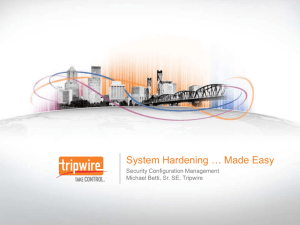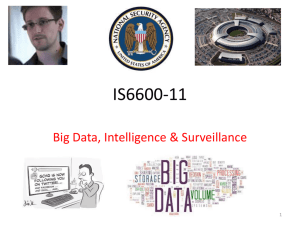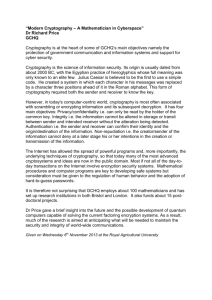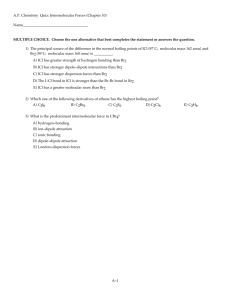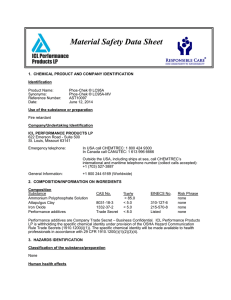GCHQ and UK Computer Policy Please respect intellectual property rights
advertisement
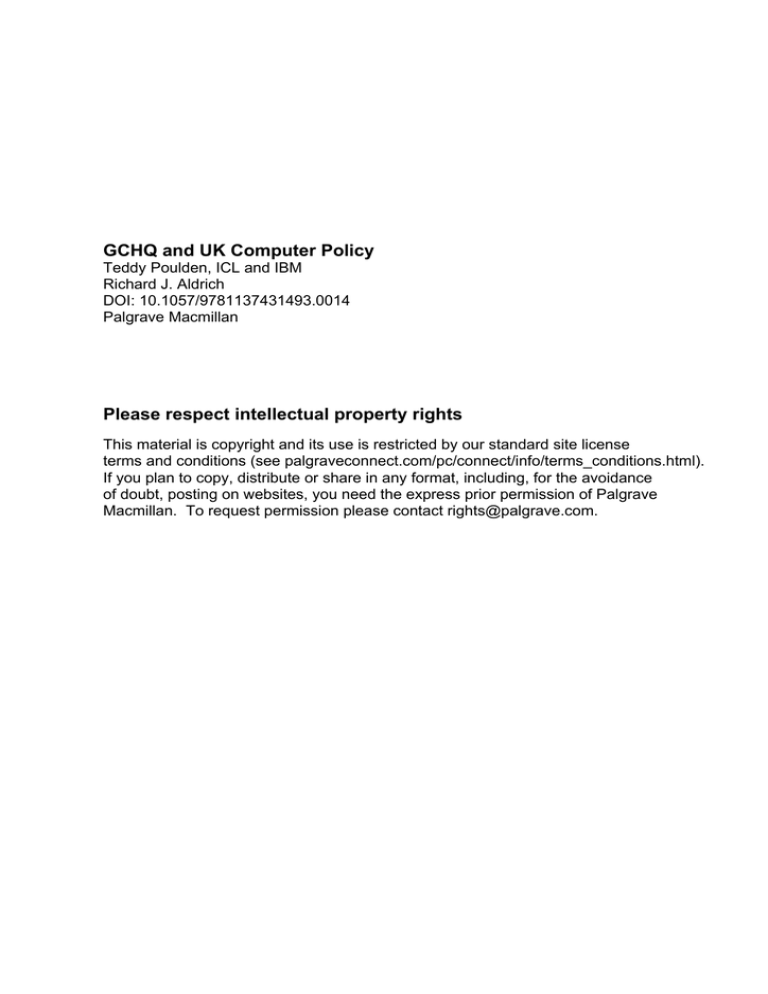
GCHQ and UK Computer Policy Teddy Poulden, ICL and IBM Richard J. Aldrich DOI: 10.1057/9781137431493.0014 Palgrave Macmillan Please respect intellectual property rights This material is copyright and its use is restricted by our standard site license terms and conditions (see palgraveconnect.com/pc/connect/info/terms_conditions.html). If you plan to copy, distribute or share in any format, including, for the avoidance of doubt, posting on websites, you need the express prior permission of Palgrave Macmillan. To request permission please contact rights@palgrave.com. 10 GCHQ and UK Computer Policy Richard J. Aldrich Government Communications Headquarters or ‘GCHQ’ is Britain’s largest intelligence agency. Currently commanding some 6,000 employees, it moved to new premises in Cheltenham in 2003 which for the previous few years constituted the largest building project in Europe and which is known locally as the ‘Doughnut‘. GCHQ, together with its defensive arm, the Communications-Electronics Security Group and their various historical predecessors have presided over the complex matter of gathering intelligence from the ether and also attempting to protect the security of British codes and ciphers for more than a century.1 In GCHQ’s distinctive new building international relations meets big science. Deep below the offices of the linguists and the analysts are vast computer halls. The exact size and type of these computers are secret but GCHQ is rumoured to have several machines each with a storage capacity of 25 petabytes (25,000 terabytes) equipped with over 20,000 cores to provide rapid parallel processing. Such computers are required for only a few specialist scientific tasks: simulating complex weather systems, mapping the human genome, designing nuclear weapons and of course cryptography – the science of making and breaking ciphers.2 Cryptography is one of the core activities of all signals intelligence organisations. For many years signals intelligence was a serious lacuna in our understanding of post-war international history. This problem has been addressed over the last ten years, albeit the subject still remains problematic for historians to attack on anything other than a piecemeal basis.3 What we have so far failed to address is the history of interface between GCHQ and Britain’s post-war research, education and science base. We know a great deal about Bletchley Park’s wartime contribution 240 10.1057/9781137431493 - Shaping British Foreign and Defence Policy in the Twentieth Century, Edited by Malcolm Murfett Copyright material from www.palgraveconnect.com - licensed to University of Warwick - PalgraveConnect - 2014-12-01 Teddy Poulden, ICL and IBM to early computing and about important figures such as Alan Turing, but we know less about what happened after 1945.4 Unlike, MI5 and MI6, which were ‘tiddlers’ in terms of the scale of their activity, GCHQ had an impact on various aspects of national life ranging from space programmes to language teaching. Typically, when the University Grants Committee was considering the future of Chinese language provision in British Universities, the committee was steered by Arthur Cooper, GCHQ’s eminent sinologist and brother of Josh Cooper who had headed the Air Section at Bletchley Park. This chapter seeks to illustrate the way in which GCHQ had the potential to impact on wider aspects of national life by examining one small aspect: the role of a single GCHQ officer, Commander Teddy Poulden, in the context of British government policy towards the computer industry in the early 1970s.5 In the 1970s, GCHQ enjoyed access to excellent computers. Whereas other areas of British government were continually under pressure to take under-performing machines from the ailing British computer industry, GCHQ could always play the trump card of Anglo-American compatibility. The need to be able to work with its American partner, the United States National Security Agency (NSA) meant that they were allowed to buy from the world-leader in computers, America’s IBM. By the mid-1960s, IBM was in a position that British officials described as ‘oligopoly’, enjoying 70–80 per cent of the world’s market and spending £30 million a year on research and development. IBM easily recovered these costs through production runs of thousands of machines. GCHQ bought IBM computers not only because of the need for NSA compatibility but also because its machines were cutting edge and delivered outstanding performance.6 In 1977 GCHQ was also one of the first organisations to acquire one of the fabled CRAY supercomputers, designed by Seymour Cray at his Chippewa Falls plant in Minnesota which delivered fantastic parallel processing power. This helped GCHQ in its struggle to stay in the premier league of cryptography. At Cheltenham a special supply of chilled water has to be arranged to cool this new suite of equipment.7 Partly because GCHQ tended to buy American, it is sometimes assumed that it had less impact upon the UK computer industry in the 1970s than its American counterpart. While this is true to some extent, GCHQ nevertheless exerted some influence since it was called in to look at the British computing industry during the 1970s in an advisory capacity rather than as a consumer. This came largely in the form of one person, Teddy Poulden, who was lent by GCHQ to the Cabinet Office as 10.1057/9781137431493 - Shaping British Foreign and Defence Policy in the Twentieth Century, Edited by Malcolm Murfett Copyright material from www.palgraveconnect.com - licensed to University of Warwick - PalgraveConnect - 2014-12-01 Richard J. Aldrich 241 an adviser. Poulden was, in many ways, an unlikely figure for this role. He was a general signals intelligence manager rather than a computer specialist. Poulden had been born in 1915 and had joined the Navy as a cadet. An adept signals officer, he had been the communications officer on the latest British battleship HMS Prince of Wales when Churchill had steamed to Placentia Bay to meet Roosevelt in August 1941. In 1942 he served as the signal staff officer on HMS Anson, the flagship of Vice Admiral Fraser then second in command of the Home Fleet.8 Poulden had cut his teeth on signals intelligence while helping Commander Bruce Keith to run the vast British naval Sigint station on Ceylon during the war called HMS Anderson. Anderson mostly served the needs of Admiral Lord Louis Mountbatten and South East Asia Command, together with the East Indies Fleet.9 Poulden’s first postwar job had been to develop the nascent Australian Sigint organisation, the Defence Signals Bureau (DSB).10 Four Australian applicants for the directorship were rejected in favour of Britain’s Poulden, who filled the senior posts with 20 GCHQ staff and communicated with GCHQ in his own special cipher.11 When New Zealand joined UKUSA, the world-wide post-war Sigint alliance of English speaking nations, Australia’s DSB initially signed on New Zealand’s behalf, and so the signature of the fabled UKUSA agreement is that of Teddy Poulden.12 Along with John Somerville and John Borough, Poulden was one of several naval officers who were important to the development of GCHQ in the two decades following World War II. In the 1950s and 1960s, he occupied key posts, succeeding Bill Bonsall as Head of J Division (the large and prestigious Soviet section) and served as SUKLO, the GCHQ liaison officer in Washington. The latter posting allowed him insight into the enormous effort that NSA was making to harvest the possibilities of advanced technology for intelligence gathering and processing, including the early use of satellites. Poulden liked computers and after his spell as liaison at NSA at a time of increasing automation, he returned to GCHQ to occupy the post of Co-ordinator of Technical Services with a brief to watch over the computer section known as X Division.13 Dick White, the new go-ahead Intelligence Co-ordinator in the Cabinet Office, was another computer enthusiast. In 1968, White had been appointed to the new post of Cabinet Office Intelligence Coordinator as part of the Trend reforms of the UK central intelligence machinery.14 White was expected to exercise a coordinating role and assist Burke Trend, the Cabinet Secretary, in the increasingly vexed matter of preparing budgets for the secret service. White believed that computers might well deliver not only better performance but also cost savings.15 10.1057/9781137431493 - Shaping British Foreign and Defence Policy in the Twentieth Century, Edited by Malcolm Murfett Copyright material from www.palgraveconnect.com - licensed to University of Warwick - PalgraveConnect - 2014-12-01 242 GCHQ and UK Computer Policy In February 1969, White was chatting to Joe Hooper, the Director of GCHQ, about new technologies. Hooper happened to mention a new American system called COINS (Community On-line Intelligence System) that was intended to provide a shared database across the whole US intelligence community. White was excited and asked him for a detailed appraisal. Hooper rather relished giving White the doleful story. Begun in 1965 as a presidential initiative by Lyndon Johnson, who was an intelligence enthusiast, after four years and vast expense it was still not working. Led by NSA, COINS was a packet-switched network intended to connect organizations across the US intelligence community. The idea was to allow access by all the agencies to each other’s computerised files, together with ‘read-only’ access for the Pentagon and the State Department. However, it exhibited many of the classic problems of larger networks. There were ‘major difficulties’ with different file formats and divergent terminologies. There was also vast duplication but the committee set up to address this had ‘got nowhere’. There were constant technical failures and so ‘less than 20% of the enquiries receive answers’.16 Dick White was not deterred. A huge fan of new technology, by early 1970 he had persuaded the Joint Intelligence Committee to get busy in this area. Brian Stewart, Secretary of the Joint Intelligence Committee, arranged for a new group to be created on Automatic Data Processing which also comprised MI5, SIS, the Defence Intelligence Staff and the Foreign Office. Poulden from GCHQ was given the task of chairing it.17 GCHQ and NSA had just completed a shared computer project to standardise geographical locations in Russian and their spelling.18 What GCHQ really thirsted for was progress on machine translation, but so far this had failed on grounds of high costs and complexity. The Defence Intelligence Staff had looked at storing more of its material on computer but had been horrified by the sheer labour required to keep such databases current.19 Despite these early disappointments, they all recognised that NSA’s growing use of computers for data-storage and the arrival of automatic message switching meant this was the shape of the future. ‘Most Sigint end-product already contained simple machine symbols’ a result of its journey through the communications system. As a consequence, ‘NSA already maintained an almost complete file of Sigint end-product for retrieval’ on computer. By June 1971, Poulden was predicting that these changes would spread through the entire Western intelligence community over the next ten years, although like Hooper, he regarded COINS as a complex and costly failure.20 A few years later, Dick White’s 10.1057/9781137431493 - Shaping British Foreign and Defence Policy in the Twentieth Century, Edited by Malcolm Murfett Copyright material from www.palgraveconnect.com - licensed to University of Warwick - PalgraveConnect - 2014-12-01 Richard J. Aldrich 243 successors as Intelligence Co-ordinator, Joe Hooper and then Brooks Richards, were looking more closely at Automatic Data Processing in a desperate effort to cut staff numbers in the face of swingeing cuts to the intelligence and defence budgets during the early 1970s.21 The very largest computers were effectively seen as strategic weapons that could be deployed for both high-grade cryptography and also for the design of nuclear weapons. Inevitably, by the early 1970s, computers for Sigint and nuclear weapons had acquired a sensitive European dimension. Vice-Admiral Louis Le Bailly, the Director-General of Defence Intelligence, explained that they raised the spectre of what was called ‘the Trojan Horse syndrome’. This meant international corporations buying up strategically important national industries and then subjecting them to external control. The French computing industry was a classic case. In 1972 Machines Bull, the leading French manufacturer of mainframe computers, was taken over by the US international corporation General Electric. Bull was the only company in France capable of supplying the enormous ‘number crunching computers essential for the development of the French independent nuclear programme’ known as the ‘Force de Frappe’. As part of an American combine it was subject to American regulation. This forbade the supply of such computers to the French government under the Non-Proliferation Treaty. Accordingly, although the technology that Paris required was available from a French company, it could not access it. Much the same issues applied to machines required for cryptanalysis.22 Teddy Poulden confirmed that they could not work with France on computer security issues because GCHQ made use of American expertise which was ‘subject to stringent regulations precluding disclosure to third parties’.23 In the early 1970s, Poulden was co-opted into a high-level government task-force on the future of the troubled British computer industry. In the past, Britain had arguably indulged in too many small-scale computer ventures. Absurdly, at one time the UK was producing more different models of computer than the United States. In the late 1960s, Harold Wilson’s government had addressed this through a government assisted ‘Computer Mergers Scheme’ that combined the many ailing companies into a Frankenstein creation called International Computers Limited (ICL).24 This had involved pulling together elements of companies such as International Computers and Tabulators, Elliott Automation and English Electric-Leo-Marconi Computers (who had bought the computer element of J. Lyons). The Ministry of Technology acted ‘as both marriage broker and godfather’. Tony Benn at the Ministry 10.1057/9781137431493 - Shaping British Foreign and Defence Policy in the Twentieth Century, Edited by Malcolm Murfett Copyright material from www.palgraveconnect.com - licensed to University of Warwick - PalgraveConnect - 2014-12-01 244 GCHQ and UK Computer Policy of Technology had presided over this exercise.25 This was part of the same government strategy of modernization through intervention and merger that created British Leyland.26 The important connections between computing, defence and intelligence had already been made clear to ministers from the first days of ICL’s existence. In 1968, Tony Benn had developed a scheme to allow ICL to export to the Soviet Union, but this was vetoed by the Pentagon and his own Foreign Office. In April of that year, Moscow wanted to sign a deal with a UK trade delegation to Moscow that would have allowed the bulk purchase of ICL’s System 4 and Series 1900 mid-range computers. Soviet officials tempted the British with the offer of a complete British monopoly of the Soviet market, which was then thought to be worth £200 million – almost ten times the annual government subsidy to ICL. American opposition, channelled through the Foreign Office, prevented the deal from going ahead. Prime Minister Harold Wilson was told in no uncertain terms that such an agreement would be seen as a breach of ‘Cocom’, the Western regime of export restrictions designed to slow Soviet strategic weapons development. The US threatened to stop exports of computer components to Britain, including supplies to ICL. Wilson initially planned to stand firm against Washington. But when UK diplomats were prevented from attending defence and trade discussions, Wilson backed down. Thereafter, ICL focused on the British home market.27 As late as April 1971, to all outward appearances, ICL looked in good shape. However, in reality the financial position of the company was deteriorating fast and by the autumn of that year, the Department of Trade and Industry had asked worried Treasury officials for subsidies amounting to £25 million over a five year period.28 Ted Heath’s new think tank, the Central Policy Review Staff (CPRS) led by Lord Rothschild, was chosen to undertake an investigation of the problem.29 It was asked to look at overall government strategy on computers including what they called the ‘problem of lame ducks’, direct subsidies, the role of government purchasing of computers (which was recognised as an important source of indirect subsidy) and finally European co-operation.30 The CPRS were looking for a big brain to help them and Sir Alan Cottrell, the senior defence scientist, recommended Teddy Poulden. Poulden was initially worried that participating in this review would disturb his good relations with the Department of Trade and Industry, who supplied some of GCHQ’s equipment. However, after some negotiation with Joe Hooper, it was agreed that Poulden would 10.1057/9781137431493 - Shaping British Foreign and Defence Policy in the Twentieth Century, Edited by Malcolm Murfett Copyright material from www.palgraveconnect.com - licensed to University of Warwick - PalgraveConnect - 2014-12-01 Richard J. Aldrich 245 be released to the CPRS on a part-time basis for the computer study. The project leader at CPRS was Peter Carey and they were joined by William Plowden, James Joll and Sir Brian Flowers.31 Teddy Poulden instantly warmed to Lord Rothschild who asked him to prepare an overview paper drawing on the experience of his GCHQ colleagues.32 Poulden confessed that GCHQ was an ‘atypical’ user of computing resources. So he talked broadly about GCHQ and its American partner the US National Security Agency, while also trying to think of the typical user’s point of view. In summary, Poulden did not think that Britain needed to control the supply of its computer resources or maintain a separate computer industry as a strategic asset. Nor was the balance of payments an issue given ICL’s modest exports. Instead Poulden argued that the dominant factor in their considerations should be what is now known as Moore’s Law.33 This law states that processor power was doubling every two years affecting both communications and computers: The remarkable thing about communications technology is that, in many respects, it has shown such unimpeded growth over decades and with no regard to national boundaries . . . In its much shorter life computer technology has followed the same sort of pattern, but the growth rates have been greater . . . The ‘size’ and ‘power’ of the most powerful computer to date is increasing at a rate of 10 times in 5 years. What did this mean for the future of ICL? Quite simply, it meant that research in information and communications technologies was racing ahead. Poulden asserted, research time-cycles had to be kept short and this demanded serious investment that only high volume manufacturers would be able to afford. In short, he concluded ‘computing is costly’ and needed higher volumes of manufacturing to support the intense research and development activity. In his opinion, the upshot of this was that ICL would only achieve adequate volume as part of a bigger combine, perhaps with European firms.34 Poulden narrated GCHQ’s own experience with ICL for the benefit of the Cabinet Office. GCHQ had a current contract for an ICL 4–70 system. They had been asked to buy this for what Poulden politely described as government policy reasons, and Cheltenham had quickly allocated it to a peripheral task (since their central computer group which undertook mainstream cryptanalysis would not even look at it). Because ICL knew they had a captive customer, their performance had 10.1057/9781137431493 - Shaping British Foreign and Defence Policy in the Twentieth Century, Edited by Malcolm Murfett Copyright material from www.palgraveconnect.com - licensed to University of Warwick - PalgraveConnect - 2014-12-01 246 GCHQ and UK Computer Policy been poor in every respect. The machine had eventually worked because GCHQ had expended endless time and talent on it. However, Poulden added, there were very few customers in either the public or private sectors who were willing to do ICL’s work for them in this way or indeed who had the expertise close at hand to tinker endlessly with a problematic system.35 In recent years, GCHQ had been put under some duress to buy some ‘very large computers’ for central computing from ICL. GCHQ had resisted the ‘pressure’ since this meant ICL’s dreadful ‘Project 52’ machine which Poulden regarded as notoriously weak. ‘No-one would buy it given a free choice’ he sneered. Other parts of government had found that their ‘arms had been twisted’ and had given in to pressure.36 One of Poulden’s greatest pleasures was taking ‘a formidable party’ from GCHQ to listen to a presentation by ICL on the ‘Project 52’ machine. Poulden took five specialists including the renowned Professor Robert Churchhouse. In the early 1960s, Churchouse had helped to set up the Atlas Computer Laboratory at the Atomic Energy Research Establishment at Harwell, one of largest computer projects in Britain. He had then transferred to GCHQ as a systems analyst and had followed the troubled history of ‘Project 52’ at a distance. Poulden explained with relish that Churchhouse knew more about the past mistakes of ICL’s component elements than did its current management.37 In the summer of 1971, ICL’s ‘Project 52’ was several years behind IBM, whose comparable model was already on the market. Absurdly, ICL management were determined to make it non-compatible with IBM, despite the fact that their own scientists had warned them this would ensure that it would ‘fall flat on its face’.38 Poulden explained that even the recent Russian RYAD system was designed to take IBM software as one of the easiest ways of increasing performance. No-one, Poulden complained, seemed to understand the importance of software.39 Poulden derided ICL’s ‘Project 52’ as a projection of a pompous desire for national independence, akin to the precarious French nuclear deterrence system known as the ‘Force de Frappe’.40 GCHQ could always escape the pressure to purchase from ICL by citing the need for compatibility with the American code-breakers at NSA, but their masters at the Foreign Office did not have the same privilege and were being browbeaten into buying ICL. So miserable were the Foreign Office about this that they were resisting computerisation per se because of their deep fear of under-performing ICL machines.41 Looking to the future, Poulden predicted that government would have to pump £50 million over five years into ICL if its planned ‘New Range’ 10.1057/9781137431493 - Shaping British Foreign and Defence Policy in the Twentieth Century, Edited by Malcolm Murfett Copyright material from www.palgraveconnect.com - licensed to University of Warwick - PalgraveConnect - 2014-12-01 Richard J. Aldrich 247 of computers were to stand a chance of competing in world markets. Poulden’s judgements were harsh but accurate and reflected inside information because GCHQ’s X Division, which provided central computing, worked so closely with IBM. Poulden told government frankly that the subsidy would be required simply to bring down the costs of the ‘New Range’ to a point where it could compete with IBM. Meanwhile he suggested that it would certainly take five years ‘to correct management failings in ICL’.42 In October 1971, Poulden had invited key players for a day of so-called ‘rambunctious interchanges’ with X Division at Cheltenham. Douglas Nicoll of the Department of Trade and Industry was there and argued for closer collaboration with the French. However, X Division had explained that this would not work – since they would still not have large enough economies of scale and yet would have the increased costs of working across two countries.43 Officials were exasperated because they knew that to simply throw in the towel completely on ICL was not an adequate solution: there would be ‘massive expense’ incurred by all their current British customers who would lose systems support. A high proportion of these customers were British government departments.44 ICL was visibly in trouble by February 1972, underlined by the resignation of its chairman Sir John Wall.45 Poulden continued to assist during 1972, sending in another technical team from GCHQ led by Paul Foster, a bright P-Division staffer, to probe ICL’s so-called ‘New Range’ on which government ministers were pinning considerable hopes.46 Poulden also brought insider intelligence on IBM. One of the reasons that he was downbeat about the British industry was that he had been able to obtain information on new breakthroughs by IBM. Early in 1972, he had warned that IBM were bringing forward radical new changes in technology and pricing that would make it difficult for their competitors around the world, whom officials increasing referred to as ‘the remaining dwarfs’. This included a marked reduction in the price of memory, innovations in software writing and a major upgrade of their current 370 range. On 31 July 1972, Poulden rang the Cabinet Office with a tip-off that many of these changes would be announced in the coming week. IBM’s intention was to ‘put a spoke in the wheel of a Japanese competitor’, by which he probably meant Fujitsu, but Poulden observed that it would also damage ICL’s so-called ‘New Range’ machines. The Cabinet Office agonised over how to respond to this piece of confidential commercial intelligence, observing: ‘Poulden has come by it in his GCHQ capacity’ and could not give it directly to Trade and Industry.47 Even at that moment, ICL were using Sir Arnold Weinstock to try to persuade 10.1057/9781137431493 - Shaping British Foreign and Defence Policy in the Twentieth Century, Edited by Malcolm Murfett Copyright material from www.palgraveconnect.com - licensed to University of Warwick - PalgraveConnect - 2014-12-01 248 GCHQ and UK Computer Policy Ted Heath that although ICL required ‘massive government support’ at present – it might be able to stand on its own two feet within two years. However, Poulden’s intelligence on ‘the latest IBM moves’ convinced Cabinet Office officials that such hopes were ‘chimeral’ (sic) and that the ICL ‘New Range’ was doomed.48 By May 1973, Britain was facing some tough choices. All this was set against a general deterioration in the UK economic situation which presented the government with an unprecedented level of difficulty. Plowden had even begun to talk to Lord Rothschild about the possibility of ‘dropping ICL’. Although, Plowden fundamentally believed that supporting ICL was a worthwhile cause, the problem was how to do this ‘without forcing public sector users to buy unsuitable ICL systems’.49 ICL finally introduced its ‘New Range’ in October 1974 after some £25 million in government aid. ICL continued to struggle on through the 1970s, attempting to address many of the structural problems that Poulden had identified and making losses of £10–20 million a year. However, Poulden was probably wrong about the ICL ‘New Range’ – later known as the 2900 series – which did better than expected. The computer was a truly radical design and used a unique Virtual Machine Environment (VME) software which delivered decent performance. The down-side was that it was not IBM compatible which made foreign customers nervous of investing in it on any scale. Nonetheless, there were significant contracts from government including the Post Office, the Inland Revenue, the Department of Pensions and the Ministry of Defence. ICL also had a strong customer base with local authorities. By the late 1970s, however, ICL was once again in financial trouble as it sought to create a successor to the 2900 series.50 In 1981, Robb Wilmot, managing director of ICL, concluded an agreement with Fujitsu to help create the next generation of computers to replace the ‘New Range’ 2900 series machines. Some criticised this deal, but at this point the only other alternative was probably to build IBM clones. Paying Fujitsu some £17 million, it bought chip technology that allowed them to develop new machines that ran the VME software written for 2900, but faster and more efficiently.51 Fujitsu was one of the world’s best semiconductor manufacturers and eventually became a strong manufacturer of desk top PCs. ICL’s relationship with Fujitsu began in a limited way because ICL needed a cheaper source of technology, but in November 1990 Fujitsu bought all of the company and dropped the ICL brand. In this respect, the structural observations of Teddy Poulden and X Division about the need for merger and higher volumes of production and investment were probably correct.52 10.1057/9781137431493 - Shaping British Foreign and Defence Policy in the Twentieth Century, Edited by Malcolm Murfett Copyright material from www.palgraveconnect.com - licensed to University of Warwick - PalgraveConnect - 2014-12-01 Richard J. Aldrich 249 250 GCHQ and UK Computer Policy I am indebted to the British Academy for funding some of the research for this chapter. Parts of it were read at the Cambridge Intelligence Seminar at Corpus Christi College Cambridge in April 2012 and at the Centre for the History of Science, Technology and Medicine seminar at the University of Manchester in April 2013 and I am grateful for the questions and comments received. Errors remain the responsibility of the author. Notes 1. The history of British communications security is an especially important area that has long been neglected. For a path-breaking essay on cipher and document security see, D. Dilks, ‘Flashes of Intelligence: The Foreign Office, The SIS and Security Before the Second World War’, in C. Andrew and D. Dilks (eds), The Missing Dimension: Governments and Intelligence Communities in the Twentieth Century (London: Macmillan, 1982), pp. 101–25. More recently see J. Ferris, ‘The British “Enigma”: Britain, Signals Security and Cipher Machines, 1906–1946’, Defense Analysis, 3, 2 (1987), pp. 153–63 and also R.A Ratcliff, Delusions of Intelligence: Enigma, Ultra, and the End of Secure Ciphers (Cambridge, Cambridge University Press, 2006). 2. R.J. Aldrich, ‘The Ultimate Spy: Why the Real James Bond is a Supercomputer’, BBC Science Magazine, 248 (November 2012), pp. 55–9. 3. See for example Matthew Aid, Secret Sentry: The Top Secret History of the National Security Agency (New York: Bloomsbury 2009); Matthew Aid and Cees Wiebes (eds), Secrets of Signals Intelligence During the Cold War and Beyond (London: Frank Cass, 2001); D. Ball and D. Horner, Breaking the Code: Australia’s KGB Network (Sydney: Allen and Unwin, 1988); J. Bamford, The Puzzle Palace: America’s National Security Agency and Its Special Relationship with GCHQ (London: Sidgwick & Jackson, 1983); J. Bamford, Body of Secrets: How NSA and Britain’s GCHQ Eavesdrop on the World (London: Doubleday, 2001). 4. However see S. Lavington, ‘In the Footsteps of Colossus: A Description of Oedipus’, IEEE Annals of Computing, (2006), pp. 44–55. On wartime and the emergence of computers there is a vast literature. See especially B.J. Copeland, Colossus: The Secrets of Bletchley Park’s Codebreaking Computers (Oxford: Oxford University Press, 2006); P. Gannon, Colossus: Bletchley Park’s Greatest Secret (London: Atlantic Books, 2006); A. Hodges, Alan Turing: The Enigma (London: Burnett Books, 1992); W.W. Chandler, ‘The Installation and Maintenance of Colossus’, IEEE Annals of the History of Computing, 5, 3 (1983), pp. 260–2; A.W. Coombs, ‘The Making of Colossus’, IEEE Annals of the History of Computing, 5, 3 (1983), pp. 253–9; T. Sale, ‘The Colossus of Bletchley Park – The German Cipher System’, in R.H. Rojas (ed.), The First Computers: History and Architecture (Cambridge, MA: The MIT Press 2000) pp. 351–64. 5. Correspondence in the papers of Arthur Cooper (presently in private hands). On Josh Cooper, see A. Bonsall, ‘Bletchley Park and the RAF Y Service: Some Recollections’, Intelligence and National Security, 23, 6 (2008), pp. 827–41. 10.1057/9781137431493 - Shaping British Foreign and Defence Policy in the Twentieth Century, Edited by Malcolm Murfett Copyright material from www.palgraveconnect.com - licensed to University of Warwick - PalgraveConnect - 2014-12-01 Acknowledgements 6. Laver (T) to Lees (T), 4 Jan. 1965, T 224/1127, UK National Archives (UKNA). See also Couzens (T) to Henley (DEA) memo, ‘The Government and the British Computer Industry’, 4 Jan. 1965, ibid. 7. Burnett, Tate & Partners, ‘GCHQ Phase II, Benhall Site, Cheltenham’, 9 Sept. 1976, CM 23/133, UKNA. 8. Barrie H. Kent, Signal! A History of Signalling in the Royal Navy (East Meon: Hyden, 2004) pp. 140–2. 9. R.J. Aldrich, Intelligence and the War Against Japan: The Politics of Secret Service (Cambridge: Cambridge University Press, 2000) p. 236. See also D. Ford, Britain’s Secret War Against Japan, 1937–1945 (London: Routledge, 2006) p. 210; P. Elphick, Far Eastern File: The Intelligence War in the Far East 1930–1945 (London: Hodder & Stoughton, 1998) pp. 94–105; M. Smith, The Emperor’s Codes: Bletchley Park and the Breaking of Japan’s Secret Ciphers (London: Bantam, 2000) pp. 207–16; M. Smith, ‘An Undervalued Effort: How the British Broke Japan’s Codes’, in M. Smith and R. Erskine (eds), Action this Day (London: Bantam, 2001) pp. 127–51; A. Stripp, Codebreaker in the Far East (London: Frank Cass, 1989). 10. Ball and Horner, Breaking the Codes, pp. 167–9, 314. 11. C.M. Andrew, ‘The Growth of the Australian Intelligence Community and the Anglo-American Connection’, Intelligence and National Security, 4, 2 (1989), pp. 213–57. 12. N. Hager, Secret Power: New Zealand’s Role in the International Spy Network (Nelson: Craig Potton, 1996), pp. 61–3. 13. ‘Obituaries: Lt-Cdr Teddy Poulden’, Daily Telegraph (London), 20 November 1992. Poulden’s period of service as SUKLO in Washington was somewhat truncated on account of some local difficulties. After retiring from GCHQ in the 1970s he became the first head of computing at SIS. 14. J.W. Young, ‘The Wilson Government’s Reform of Intelligence Co-ordination, 1967–68’, Intelligence and National Security, 16, 1 (2001) pp. 133–51. The Trend reforms echoed a wider review of government under Fulton. 15. R.J. Aldrich, ‘Counting the Cost of Intelligence: The Treasury, National Service and GCHQ’, English Historical Review, 128, 532 (2013), pp. 596–627. 16. Hooper (D/GCHQ) to White (CAB), D/7873/1802/13, 3 March 1969, CAB 163/119, UKNA. 17. Poulden (GCHQ) to Stewart (Sec. JIC), D/8987/1402/37, ‘JIC (A) SubCommittee on Automatic Data Processing’, 29 September 1969, CAB 163/119, UKNA. This initiative was strongly steered by GCHQ since Poulden was in the chair, the GCHQ representative was H. Long and the secretary, also provided by GCHQ, was J.R. Cheadle. 18. JIC (A) (ADP) (71) 1st mtg., 15 February 1971, CAB 182/81, UKNA. 19. JIC (A) (ADP) (70) 2nd mtg., 3 August 1970, CAB 182/75, UKNA. 20. JIC (A) (ADP) (71) 2nd mtg., 14 June 1971, CAB 182/81, UKNA. 21. COS (73) 13th mtg. (4), ‘The Intelligence Co-ordinator’s Annual Review of Intelligence 1975 and His Report on Reductions in Intelligence Expenditure’, 15 May 1975, DEFE 32/22, UKNA. 22. MoD memo. ‘The Impact of the International Corporation UK Defence Policy’, 1972, File 7, Box 5, Le Bailly papers, Churchill Archives, Churchill College Cambridge. 23. JIC (A) (ADP) (72) 2nd mtg., 19 Jun. 1972, CAB 182/81, UKNA. 10.1057/9781137431493 - Shaping British Foreign and Defence Policy in the Twentieth Century, Edited by Malcolm Murfett Copyright material from www.palgraveconnect.com - licensed to University of Warwick - PalgraveConnect - 2014-12-01 Richard J. Aldrich 251 24. The definitive history of ICL is Martin Campbell-Kelly, ICL: A Business and Technical History (Oxford: Clarendon Press, 1989). 25. Minitech, ‘A History of the Computer Mergers Scheme, 1964–1969’, 9 June 1969, T 325/161, UKNA. 26. Glen O’Hara, ‘Attempts to Modernize: Nationalization and the Nationalized Industries in Post-War Britain’, in Franco Amatori, Robert Millward and Pier Angelo Toninelli (eds), Reappraising State-Owned Enterprise: A Comparison of the UK and Italy (London: Routledge, 2011) pp. 50–67. 27. ‘Uncle Sam’s Nyet to ICL Deal’, 6 January 2000, Computing.co.uk, online at: http://www.computing.co.uk/ctg/news/1853985/uncle-sams-nyet-icl-deal [accessed 8 april 2014] On the wider effects of Cocom see, M. Mastanduno, Economic Containment: CoCom and the Politics of East-West Trade (Ithaca: Cornell University Press, 1992). 28. Plowden (CPRS) to Rothschild (CPRS), ‘Government and ICL’, 26 April 1972, CAB 184/63, UKNA. 29. Campbell-Kelly, ICL, pp 284–6. On CPRS see Christopher Pollitt, ‘The Central Policy Review Staff 1970–1974’, Public Administration, 52, 4 (1974), pp. 375–92 and also Rodney Lowe, The Official History of the British Civil Service: Reforming the Civil Service, Vol. 1: The Fulton Years, 1966–81 (London: Routledge, 2011) pp. 155–90. The functions of the CPRS were mostly transferred to the Downing Street Policy Unit in the 1980s. 30. CPRS mtg., ‘Computers’, Q 19/1, 19 May 1971, CAB 184/13, UKNA. 31. ‘The UK Computer Industry: CPRS Action Programme’, draft May 1971, CAB 184/12, UKNA. See also Armstrong (CAB) to Part (DTI), 18 March 1971, CAB 184/13, UKNA. 32. Poulden (GCHQ) to Rothschild (CPRS), 18 March 1971, CAB 184/13, UKNA; Poulden (GCHQ) to Rothschild (CPRS), ‘UK Computer Industry’, D/2281/1801/9/4, 2 April 1971, CAB 184/12, UKNA. 33. Gordon E, Moore, the co-founder of Intel stated in a 1965 paper that the number of transistors that could be inexpensively placed on an integrated circuit or ‘chip’ was increasing exponentially and was doubling approximately every two years. See Mark Lundstrom, ‘Moore’s Law Forever?’, Science, 299, 5604 (10 January 2003), pp. 210–11. 34. Poulden (GCHQ) to Carey (CPRS), ‘Central Policy Review of the British Computing Industry’ and Attachment, D/2728/1801/9/4, 29 June 1971, CAB 184/12, UKNA. 35. Poulden (GCHQ) to Carey (CPRS), D/3466/1801/9/4, 12 November 1971, CAB 184/15, UKNA. 36. CPRS mtg., ‘Computers’, Q 19/1, 19 May 1971, CAB 184/13, UKNA. 37. Poulden (GCHQ) to Carey (CPRS), D/3193/1801/9/4, 17 September 1971, CAB 184/14, UKNA. 38. Plowden (CPRS) Memo. ‘Computers: “The Whole Future of ICL Depends on Project 52” Discuss’, 11 August 1971, CAB 184/14, UKNA. 39. Note of a mtg. between Poulden (GCHQ) and Carey (CPRS), 22 Apr. 1971, CAB 184/12, UKNA. 40. Poulden (GCHQ) to Carey (CPRS), enclosing ‘The British Computer Industry: the Requirement’, D/3191/1801/9/4, 17 September 1971, CAB 184/14, UKNA. 10.1057/9781137431493 - Shaping British Foreign and Defence Policy in the Twentieth Century, Edited by Malcolm Murfett Copyright material from www.palgraveconnect.com - licensed to University of Warwick - PalgraveConnect - 2014-12-01 252 GCHQ and UK Computer Policy 41. Poulden (GCHQ) to Carey (CPRS), D/3466/1801/9/4, 12 November 1971, CAB 184/15, UKNA. 42. Ibid. 43. Poulden (GCHQ) to Carey (CPRS), D/3337/1801/9/4, 14 October 1971, ibid. 44. Plowden (CPRS), ‘Computer’, 15 Oct. 1971, ibid. 45. Campbell-Kelly, ICL, p. 265. 46. Poulden (GCHQ) to Plowden (CPRS), D/4272/1801/9/4, 4 April 1972, CAB 184/63, UKNA. P-Division was Planning Division and a place where young potential managers were often sent to get a sense of future policy at GCHQ. 47. Ridley (CAB) to Rothschild (CPRS), ‘Innovations by IBM’, 31 July1972, CAB 184/64, UKNA. 48. Plowden (CPRS) to Rothschild (CPRS), ‘Meeting with ICL: 1 August’, 31 July 1972, ibid. 49. Plowden (CPRS) to Rothchild (CPRS), ‘ICL’, 8 May 1973, CAB 184/186, UKNA. 50. Campbell-Kelly, ICL, p. 265. 51. John Lamb, ‘Britain’s New Mainframe has a Japanese Heart’, New Scientist, 25 April 1985, p. 24. 52. Martin Campbell-Kelly, ‘The ACE and the Shaping of British Computing’, in B. Jack Copeland (ed.), Alan Turing’s Electronic Brain: The Struggle to Build the ACE, the World’s First Computer (Oxford: Oxford University Press, 2005) pp. 149–72. 10.1057/9781137431493 - Shaping British Foreign and Defence Policy in the Twentieth Century, Edited by Malcolm Murfett Copyright material from www.palgraveconnect.com - licensed to University of Warwick - PalgraveConnect - 2014-12-01 Richard J. Aldrich 253
